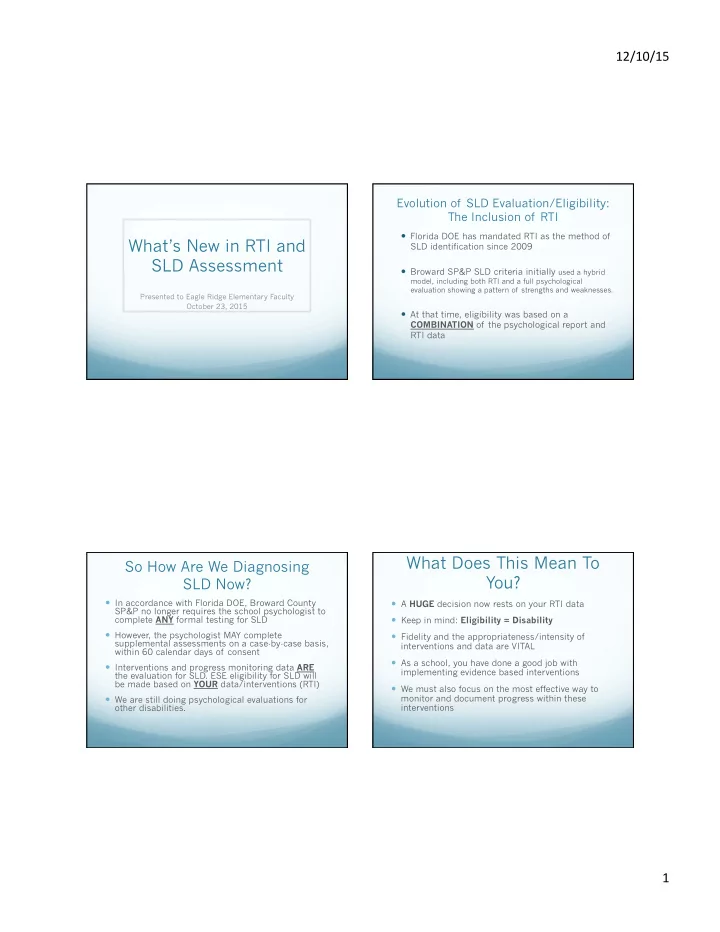

12/10/15 ¡ Evolution of SLD Evaluation/Eligibility: The Inclusion of RTI Florida DOE has mandated RTI as the method of What’s New in RTI and SLD identification since 2009 SLD Assessment Broward SP&P SLD criteria initially used a hybrid model, including both RTI and a full psychological evaluation showing a pattern of strengths and weaknesses. Presented to Eagle Ridge Elementary Faculty October 23, 2015 At that time, eligibility was based on a COMBINATION of the psychological report and RTI data What Does This Mean To So How Are We Diagnosing You? SLD Now? In accordance with Florida DOE, Broward County A HUGE decision now rests on your RTI data SP&P no longer requires the school psychologist to complete ANY formal testing for SLD Keep in mind: Eligibility = Disability However, the psychologist MAY complete Fidelity and the appropriateness/intensity of supplemental assessments on a case-by-case basis, interventions and data are VITAL within 60 calendar days of consent As a school, you have done a good job with Interventions and progress monitoring data ARE implementing evidence based interventions the evaluation for SLD. ESE eligibility for SLD will be made based on YOUR data/interventions (RTI) We must also focus on the most effective way to monitor and document progress within these We are still doing psychological evaluations for interventions other disabilities. 1 ¡
12/10/15 ¡ Tier 2 – Strategic/Targeted/ Refresher on RTI Small Group Intervention Tier 1 - Core/Universal/Whole Group Instruction TARGET specific student difficulties ALL students are in Tier 1 Delivered in addition to Tier 1 Academic – Differentiated Instruction of State/ Academic Examples ? District curriculum standards School-wide reading & math programs Behavior Examples ? (Journeys & Go Math) Behavior – School/Class-wide Behavior Plan, Whole-class strategies (CHAMPS) ** Document on BASIS ** ** Document on BASIS ** Tier 3 – Intensive Interventions Intervention Need to be EVIDENCE-BASED Delivered in addition to Tier 1 and Tier 2 Must TARGET specific area of concern Essential change is “ INTENSITY” Should be tied to diagnostic data (DAR, Increase FREQUENCY - # days/week Rigby, iReady diagnostic assessment, Go Math Prerequisite tests, etc.) Increase DURATION - # of minutes Should be implemented in all areas of Decrease in GROUP SIZE – more focused instruction need (Reading, Math, R & M, etc.) ADDING SOMETHING ELSE (an additional intervention) ** Document on BASIS ** 2 ¡
12/10/15 ¡ Progress Monitoring New Progress Monitoring Considerations Considerations For SLD eligibility, we now have to show lack of Measures must be RELATED to the target area adequate progress in a minimum of 2 comparison groups. For example, Have a baseline and expectation for comparison State Consider the rate of progress that is reasonable to District expect given the intervention program you are using School Class We are supposed to share a graph with the parent at least every 8 weeks Peer (Intervention Group) Please see us and we can help you decide what to use for comparison data Why do we need Progress Monitoring comparison data? Resources • Helps determine if the intervention is effective with all http://www.browardprevention.org/ students receiving the intervention http://www.PBISWorld.com http://www.EasyCBM.com • Useful in determining how the targeted student is achieving compared to subgroups (i.e., ELLs, etc.) http://www.InterventionCentral.org • Useful in analyzing the percentages of students responding to interventions at each tier of the RtI pyramid 3 ¡
12/10/15 ¡ Presenting at Meetings: Important Reminders So How Do We Do It? When referred for SLD evaluation, interventions and This is the easy part. You are already doing it! progress monitoring DO NOT END . Please discuss with the parents the same way you Current GRAPHED data and interventions MUST BE do in CPST meeting. For example, explain: REVIEWED & DISCUSSED with parents and the team at the ESE eligibility staffing The initial test scores that caused you concern When you implemented/intensified interventions No current interventions and/or no current data = NO Which skills the interventions are targeting ELIGIBILITY How often the interventions are given You MUST bring the following to the staffing: How the student is progressing (i.e., what is the Details of CURRENT Tier 2 and 3 interventions, and expected level of performance and is the student on CURRENT GRAPHED DATA documenting response to those track to meet that goal?) interventions SLD Eligibility Meetings: Beyond the RTI data Concluding School psychologist will present results of any Please consult with support staff supplemental evaluations completed if you need assistance We also need to consider exclusionary factors: Questions? Don’t be shy….but Vision, hearing, and motor problems Emotional and behavioral factors please remember….I am only the Cultural and socioeconomic factors messenger! Attendance and mobility rate Environmental factors Second Language Acquisition (ELLs) 4 ¡
Recommend
More recommend